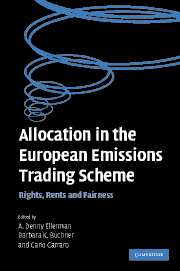Book contents
- Frontmatter
- Contents
- List of figures
- List of boxes
- List of tables
- List of contributors
- Introductory note/Foreword
- Acknowledgements
- Glossary and abbreviations
- Part I The EU ETS allocation process
- Part II Experiences from Member States in allocating allowances
- 3 United Kingdom
- 4 Germany
- 5 Denmark
- 6 Sweden
- 7 lreland
- 8 Spain
- 9 Italy
- 10 Hungary
- 11 Czech Republic
- 12 Poland
- Part III Concluding remarks and background material
- Appendix I Participants
- Appendix II The individual country outlines
- Appendix III The country tables
- Appendix IV Background material from the European Commission
- Index
12 - Poland
Published online by Cambridge University Press: 22 September 2009
- Frontmatter
- Contents
- List of figures
- List of boxes
- List of tables
- List of contributors
- Introductory note/Foreword
- Acknowledgements
- Glossary and abbreviations
- Part I The EU ETS allocation process
- Part II Experiences from Member States in allocating allowances
- 3 United Kingdom
- 4 Germany
- 5 Denmark
- 6 Sweden
- 7 lreland
- 8 Spain
- 9 Italy
- 10 Hungary
- 11 Czech Republic
- 12 Poland
- Part III Concluding remarks and background material
- Appendix I Participants
- Appendix II The individual country outlines
- Appendix III The country tables
- Appendix IV Background material from the European Commission
- Index
Summary
Introductory background and context
Poland's participation in climate protection
Poland signed the Climate Convention on 26 July 1994 and ratified the Kyoto Protocol on 13 December 2002, making the commitment to reduce greenhouse gas (GHG) emissions by 6% within the period 2008–2012 compared to the 1988 emissions. These decisions were taken in Poland after a lot of hesitation and discussions, which often expressed fears as to whether the policy of reducing CO2 emission would impose too much burden on Poland, because of the heavy domination of coal in its fuel consumption. Many concerns were expressed regarding the introduction of a ‘coal tax’, which at that time was expected to be the most realistic instrument of coal emission control. However, the political will to support the efforts of the international community on climate protection prevailed.
General economic, social and environmental context
Until the fall `of the communist political regime in 1989, the centralised economic system dominated in Poland, largely based on development of heavy industry. Special environmental policy was not carried out.
The economic transition period started in 1989, after important political changes aimed at creating a market-oriented economy. Transition costs were very high. The GDP dropped drastically during the first years and in 1991 it was 18% lower than in 1989. Unemployment rose and is in constant growth. Part of the detrimental effects have been overcome as illustrated by the systematic GDP increase since 1992.
- Type
- Chapter
- Information
- Allocation in the European Emissions Trading SchemeRights, Rents and Fairness, pp. 301 - 336Publisher: Cambridge University PressPrint publication year: 2007
- 3
- Cited by



